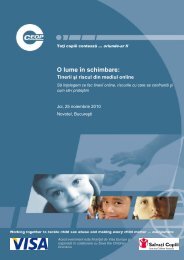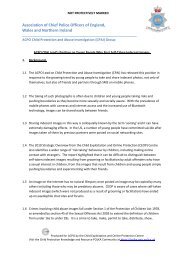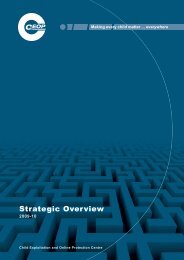Threat Assessment of Child Sexual Exploitation and Abuse - Ceop
Threat Assessment of Child Sexual Exploitation and Abuse - Ceop
Threat Assessment of Child Sexual Exploitation and Abuse - Ceop
Create successful ePaper yourself
Turn your PDF publications into a flip-book with our unique Google optimized e-Paper software.
<strong>Threat</strong> <strong>Assessment</strong> <strong>of</strong> <strong>Child</strong> <strong>Sexual</strong> <strong>Exploitation</strong> <strong>and</strong> <strong>Abuse</strong> 2013<br />
Key threats & General picture<br />
Key threats<br />
9. This assessment builds on the thinking in the 2012 TACSEA by identifying the high level key threats to children from sexual<br />
exploitation <strong>and</strong> abuse. These form the basis <strong>of</strong> the CEOP Control Strategy for 2013/14. The TACSEA will be underpinned by<br />
a strategic action plan for each key threat.<br />
10. In the majority <strong>of</strong> its forms, both online <strong>and</strong> <strong>of</strong>fline, child sexual exploitation <strong>and</strong> abuse (CSEA) remains a largely solitary crime,<br />
albeit one <strong>of</strong>ten exacerbated by the effects <strong>of</strong> group dynamics. Often where true group <strong>of</strong>fending does occur, this shares few<br />
<strong>of</strong> the characteristics traditionally associated with organised crime. CSEA <strong>of</strong>fending is, however, <strong>of</strong>ten extremely serious <strong>and</strong><br />
complex in both its execution <strong>and</strong> impact. The key threats identified in this document represent the most serious <strong>and</strong> complex<br />
areas <strong>of</strong> CSEA, including those in which organised crime is sometimes a feature.<br />
General picture<br />
11. Recent research conducted by the NSPCC 1 indicates that around 5% <strong>of</strong> UK children suffer contact sexual abuse at some<br />
point during childhood. It is likely that around 190,000 <strong>of</strong> these will fall victim to contact sexual abuse by a stranger or an adult<br />
relative (other than a parent or guardian) before turning 18. This represents an average <strong>of</strong> more than 10,000 new victims in the<br />
UK every year.<br />
12. In addition, CEOP receives reports from around 1,000 children each year concerning online victimisation by adults. A further<br />
unquantifiable number <strong>of</strong> children overseas suffer contact sexual abuse at the h<strong>and</strong>s <strong>of</strong> UK nationals visiting or living <strong>and</strong><br />
working abroad.<br />
13. In the eyes <strong>of</strong> the general public, from a child protection perspective, the second half <strong>of</strong> 2012 was dominated by reports <strong>of</strong><br />
historic sexual abuse, most notably the prolific <strong>and</strong> predatory sexual <strong>of</strong>fending <strong>of</strong> Jimmy Savile <strong>and</strong> others in the public eye.<br />
The scale <strong>and</strong> nature <strong>of</strong> the abuse able to be perpetrated by Savile - to a degree hiding in plain sight - were truly shocking <strong>and</strong><br />
abhorrent. The extent to which his <strong>of</strong>fending is indicative <strong>of</strong> today’s threat l<strong>and</strong>scape is, however, unclear. The abuse <strong>of</strong> the<br />
power <strong>and</strong> authority that comes with status, be that celebrity or otherwise, certainly remains a potential threat to children. The<br />
vulnerability <strong>of</strong> certain institutions to predatory child sexual <strong>of</strong>fenders should also not be underestimated.<br />
14. The internet <strong>and</strong> wider information <strong>and</strong> communications technology are now firmly embedded within the everyday lives <strong>of</strong> UK<br />
children. Online activity features so prominently in their entertainment, education <strong>and</strong> social lives that it is seen by them as a<br />
tool in their <strong>of</strong>fline lives. In turn, UK children are now more accessible to <strong>of</strong>fenders online, with 91% living in a household with<br />
access to the internet. The numbers <strong>of</strong> hours 12 to 15 year olds spend online each week has risen from 14.9 hours in 2011 to<br />
17.1 hours in 2012, an increase <strong>of</strong> almost 15%. 2<br />
15. The internet also <strong>of</strong>fers children the opportunity for a separate identity in which they can be whoever they wish <strong>and</strong> take risks<br />
they would never countenance <strong>of</strong>fline. It is <strong>of</strong>ten where these two worlds meet that children suffer most at the h<strong>and</strong>s <strong>of</strong> those<br />
wishing to do them harm. That a child’s internet presence is now so inextricably linked to their real world identity can only<br />
increase the impact <strong>of</strong> any exploitation they suffer.<br />
16. Whilst the edges are blurred for children, it is important to recognise that a distinction between online <strong>and</strong> <strong>of</strong>fline may remain<br />
for adult sex <strong>of</strong>fenders who <strong>of</strong>fend against children. Not only are some <strong>of</strong>fenders generationally less exposed to the internet but<br />
the existence <strong>of</strong> a delineated <strong>and</strong> seemingly anonymous online environment can bring many advantages to them.<br />
6<br />
1<br />
<strong>Child</strong> abuse <strong>and</strong> neglect in the UK today (Radford et al, 2011).<br />
2<br />
<strong>Child</strong>ren <strong>and</strong> Parents: Media Use <strong>and</strong> Attitudes Report, Ofcom, 2012.











